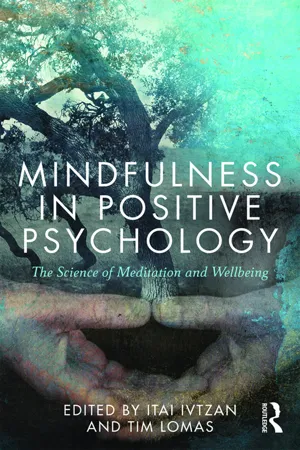
Mindfulness in Positive Psychology
The Science of Meditation and Wellbeing
- 340 pages
- English
- ePUB (mobile friendly)
- Available on iOS & Android
Mindfulness in Positive Psychology
The Science of Meditation and Wellbeing
About This Book
Mindfulness in Positive Psychology brings together the latest thinking in these two important disciplines. Positive psychology, the science of wellbeing and strengths, is the fastest growing branch of psychology, offering an optimal home for the research and application of mindfulness. As we contemplate mindfulness in the context of positive psychology, meaningful insights are being revealed in relation to our mental and physical health.
The book features chapters from leading figures from mindfulness and positive psychology, offering an exciting combination of topics. Mindfulness is explored in relation to flow, meaning, parenthood, performance, sports, obesity, depression, pregnancy, spirituality, happiness, mortality, and many other ground-breaking topics. This is an invitation to rethink about mindfulness in ways that truly expands our understanding of wellbeing.
Mindfulness in Positive Psychology will appeal to a readership of students and practitioners, as well as those interested in mindfulness, positive psychology, or other relevant areas such as education, healthcare, clinical psychology, counselling psychology, occupational psychology, and coaching. The book explores cutting edge theories, research, and practical exercises, which will be relevant to all people interested in this area, and particularly those who wish to enhance their wellbeing via mindfulness.
Frequently asked questions
Information
Part I Positive psychology interventions
1 Mindfulness-Based Strengths Practice (MBSP) for Enhancing Well-Being, Managing Problems, and Boosting Positive Relationships
We can’t understand what is happening to ‘something’ if we aren’t looking. But nothing is going to happen to that ‘something’ if we don’t look deeply. That’s why so many things with incredible potential go unnoticed because nobody bothers to look.Alejandro Gonzalez Inarritu, director of 21 Grams (2003), Babel (2006), Biutiful (2010), and Birdman (2014)
The science of mindfulness and character
© Copyright 2004–2015, VIA Institute on Character. All rights reserved. Used with permission. www.viacharacter.org The Virtue of Wisdom – cognitive strengths that entail the acquisition and use of knowledge
The Virtue of Courage – emotional strengths that involve the exercise of will to accomplish goals in the face of opposition, external or internal
The Virtue of Humanity – interpersonal strengths that involve tending and befriending others
The Virtue of Justice – civic strengths that underlie healthy community life
The Virtue of Temperance – strengths that protect against excess
The Virtue of Transcendence – strengths that forge connections to the universe & provide meaning
|
Mindfulness and character strengths integration: past and present
Table of contents
- Cover Page
- Half-Title Page
- Series Page
- Title Page
- Copyright Page
- Dedication
- Table of Contents
- Mindfulness in positive psychology: An introduction
- Part I Positive psychology interventions
- Part II Positive theory and mechanisms of mindfulness
- Part III Mindfulness for health practitioners and carers
- Part IV Mindfulness in spirituality
- Part V Mindful therapy
- Index